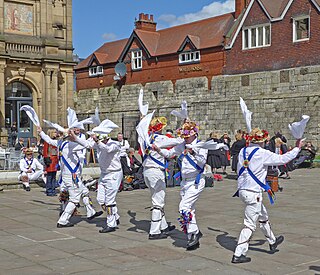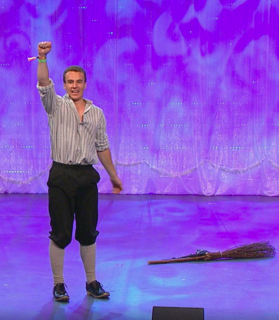
Morris dancing is a form of English folk dance usually accompanied by music. It is based on rhythmic stepping and the execution of choreographed figures by a group of dancers, usually wearing bell pads on their shins. Implements such as sticks, swords and handkerchiefs may also be wielded by the dancers. In a small number of dances for one or two people, steps are near and across a pair of clay tobacco pipes laid one across the other on the floor. They clap their sticks, swords, or handkerchiefs together to match with the dance.
Log most often refers to:

A wood block is a small slit drum made from a single piece of wood. The term generally signifies the Western orchestral instrument, though it is descended from the Chinese woodblock. Alternative names sometimes used in ragtime and jazz are clog box and tap box. In orchestral music scores, wood blocks may be indicated by the French bloc de bois or tambour de bois, German Holzblock or Holzblocktrommel, or Italian cassa di legno.

Clogs are a type of footwear made in part or completely from wood. Used worldwide, their forms can vary by culture, but often remained unchanged for centuries within a culture.

Step dance is a generic term for dance styles in which footwork is considered to be the most important part of the dance and limb movements and styling are either restricted or considered irrelevant.

Geta (下駄) are traditional Japanese footwear resembling flip-flops. A kind of sandal, geta have a flat wooden base elevated with up to three "teeth", held on the foot with a fabric thong, which keeps the foot raised above the ground.

Sandals are an open type of footwear, consisting of a sole held to the wearer's foot by straps going over the instep and around the ankle. Sandals can also have a heel. While the distinction between sandals and other types of footwear can sometimes be blurry, the common understanding is that a sandal leaves all or most of the foot exposed. People may choose to wear sandals for several reasons, among them comfort in warm weather, economy, and as a fashion choice.

Shoemaking is the process of making footwear.

Galoshes, also known as dickersons, gumshoes, rubbers, or overshoes, are a type of rubber boot that is slipped over shoes to keep them from getting muddy or wet. In the United States, the word galoshes may be used interchangeably with boot, especially a rubberized boot. In the United Kingdom, however, a galosh is an overshoe made of a weatherproof material to protect a more vulnerable shoe underneath and keep the foot warm and dry. Galoshes is also the word for shoes in the Azorean Portuguese language.
Clogging is a type of folk dance practiced in the United States, in which the dancer's footwear is used percussively by striking the heel, the toe, or both against a floor or each other to create audible rhythms, usually to the downbeat with the heel keeping the rhythm.

Clog dancing is a form of step dance characterised by the wearing of inflexible, wooden soled clogs. Clog dancing developed into differing intricate forms both in Wales and also in the North of England. Welsh clog dancing mainly originates from various slate mines where workers would compete against each other during work breaks. Northern English traditional clog dancing originates from Lancashire, Yorkshire, County Durham, Northumberland and the Lake District.

The Tree of Wooden Clogs is a 1978 Italian film written and directed by Ermanno Olmi. The film concerns Lombard peasant life in a cascina (farmhouse) of the late 19th century. It has some similarities with the earlier Italian neorealist movement, in that it focuses on the lives of the poor, and the parts were played by real farmers and locals, rather than professional actors.

Pattens are protective overshoes that were worn in Europe from the Middle Ages until the early 20th century. Pattens were worn outdoors over a normal shoe, had a wooden or later wood and metal sole, and were held in place by leather or cloth bands. Pattens functioned to elevate the foot above the mud and dirt of the street, in a period when road and urban paving was minimal.
Dutch folk dance are the traditional dances that were performed by the folk.

The International Wooden Shoe Museum Eelde is a museum in Eelde, the Netherlands, for clogs, clog-making equipment and machinery. It has the largest collection of wooden footwear in the world.

A British clog is a wooden-soled clog from Great Britain. The uppers are typically leather, and many variations exist in style and fastening.
Traditional dancing in the Netherlands is often called "Folkloristisch", sometimes "Boerendansen" ("farmer-dancing") or "Klompendansen". Wooden shoes are worn as an essential part of the traditional costume for Dutch clogging, or Klompendanskunst. Clogs for dancing are made lighter than the traditional 700-year-old design. The soles are made from ash wood, and the top part is cut lower by the ankle. Dancers create a rhythm by tapping the toes and heels on a wooden floor.
Clogs have traditionally been used in Turkish bath houses to protect the foot from dirty water and soap. The earlier form were called "nalins" and originated during the Ottoman period. Nalins came to be artistic objects which indicated the wearer's social standing. As domestic baths became more common the rituals of the bath house declined and nalins were replaced with the simpler "takunya". Takunya are also worn outside of the bath house. Since 1960 takunya have in their turn been replaced by plastic slippers which are lighter and quieter.

Welsh clog dancing is an unbroken tradition that was typically performed by slate quarry workmen and farmers. Dancers would often compete with each other to prove who had the most impressive dancing, stamina and athleticism. Welsh clog dancing also includes "tricks" which makes it unique compared to other forms of step dancing such as Irish dancing, Scottish dancing and English clog dancing. These tricks can include, but are not limited to; snuffing out a candle flame using the wooden soles of the shoes, toby stepping and high leaps into the air such as straddle jumping.












